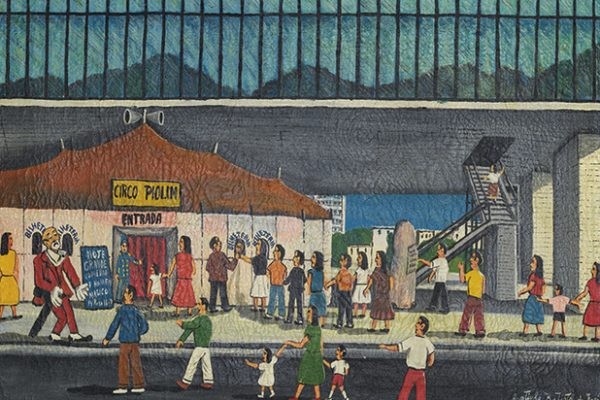Agostinho Batista de Freitas
10 Dec 2016 - 09 Mar 2017
This exhibition features seventy-four paintings executed in the period spanning from the 1950s to the 1990s, including ve canvases recently donated to MASP, adding the work of Agostinho Batista de Freitas (1927-1997) to the Museum’s holdings, thereby correcting what was previously a historical gap in the collection.
The focus here is on depictions of the city of São Paulo, a subject that occupied Batista de Freitas throughout his career. What is evident is not only the extraordinary quantity of paintings about the city, something singular for São Paulo, but also the quality and variety of these works, with a surprising diversity of compositions, colorings, points of view, and framings.
The show sheds light on Batista de Freitas’s relation with the city through various groupings of works, organized in rows, which span from depictions of the Museum’s building, on Avenida Paulista, to aerial views of downtown São Paulo, while also including scenes of daily life in the city’s north zone, where the artist lived, along with a range of different collective situations that include the subjects of travel, festivals, amusements, and religious manifestations.
Displayed within the frank and direct architecture designed by Lina Bo Bardi (1914-1992), with its transparencies and openings to the cityscape, the paintings by Batista de Freitas encourage the viewer to take an active look at São Paulo, with its complex urban dynamics, histories, and social differences.
Agostinho Batista de Freitas, São Paulo is part of a major wide-scope program developed by MASP’s artistic direction, aimed at questioning the concepts of high and low art and culture, dedicating shows to self-taught artists, often reclusive or from a humble background, operating outside the traditional circuits of the art system. These strategies are now also giving rise to the restaging of the exhibition A mão do povo brasileiro[The Hand of the Brazilian People], one of the most celebrated and controversial exhibitions ever held by the Museum, as well as organizing shows such as Portinari popular, which foster the reading of popular themes in Brazilian modernism. The idea is to construct an open, multiple, and plural Museum which is permeable to different cultures.
The biography of Batista de Freitas is intertwined with the history of MASP. It was the Museum’s founding director, Pietro Maria Bardi (1900-1999), who introduced the artist’s work into the art circuit by organizing his rst solo show, in 1952. Batista de Freitas was then just twenty- ve years old and living in Imirim District, in São Paulo’s north zone, painting and showing his works in the streets of downtown São Paulo, where Bardi met him.
An essential part of this project is the publication of an extensive catalog, with reproductions of all the artworks in the exhibition, rare documents, and period photographs, as well as six previously unpublished essays by curators and critics especially commissioned to produce new re ections about an artist marginalized by the of cial art history up until now.
Curator Fernando Oliva
The focus here is on depictions of the city of São Paulo, a subject that occupied Batista de Freitas throughout his career. What is evident is not only the extraordinary quantity of paintings about the city, something singular for São Paulo, but also the quality and variety of these works, with a surprising diversity of compositions, colorings, points of view, and framings.
The show sheds light on Batista de Freitas’s relation with the city through various groupings of works, organized in rows, which span from depictions of the Museum’s building, on Avenida Paulista, to aerial views of downtown São Paulo, while also including scenes of daily life in the city’s north zone, where the artist lived, along with a range of different collective situations that include the subjects of travel, festivals, amusements, and religious manifestations.
Displayed within the frank and direct architecture designed by Lina Bo Bardi (1914-1992), with its transparencies and openings to the cityscape, the paintings by Batista de Freitas encourage the viewer to take an active look at São Paulo, with its complex urban dynamics, histories, and social differences.
Agostinho Batista de Freitas, São Paulo is part of a major wide-scope program developed by MASP’s artistic direction, aimed at questioning the concepts of high and low art and culture, dedicating shows to self-taught artists, often reclusive or from a humble background, operating outside the traditional circuits of the art system. These strategies are now also giving rise to the restaging of the exhibition A mão do povo brasileiro[The Hand of the Brazilian People], one of the most celebrated and controversial exhibitions ever held by the Museum, as well as organizing shows such as Portinari popular, which foster the reading of popular themes in Brazilian modernism. The idea is to construct an open, multiple, and plural Museum which is permeable to different cultures.
The biography of Batista de Freitas is intertwined with the history of MASP. It was the Museum’s founding director, Pietro Maria Bardi (1900-1999), who introduced the artist’s work into the art circuit by organizing his rst solo show, in 1952. Batista de Freitas was then just twenty- ve years old and living in Imirim District, in São Paulo’s north zone, painting and showing his works in the streets of downtown São Paulo, where Bardi met him.
An essential part of this project is the publication of an extensive catalog, with reproductions of all the artworks in the exhibition, rare documents, and period photographs, as well as six previously unpublished essays by curators and critics especially commissioned to produce new re ections about an artist marginalized by the of cial art history up until now.
Curator Fernando Oliva

